TOYOTA C-HR 2020 (in English) Owner's Guide
Manufacturer: TOYOTA, Model Year: 2020, Model line: C-HR, Model: TOYOTA C-HR 2020Pages: 536, PDF Size: 11.99 MB
Page 31 of 536
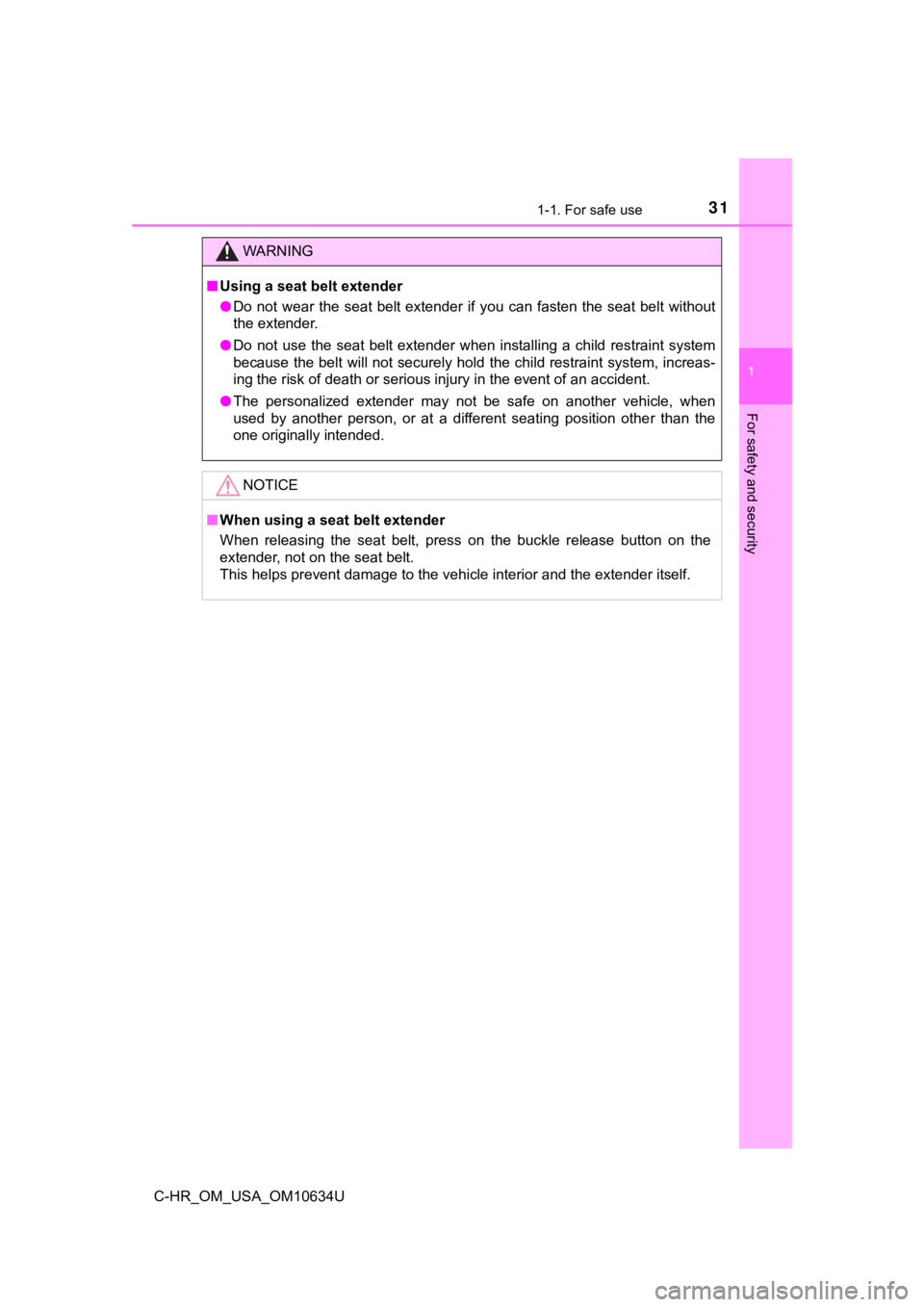
311-1. For safe use
1
For safety and security
C-HR_OM_USA_OM10634U
WARNING
■Using a seat belt extender
● Do not wear the seat belt extender if you can fasten the seat belt without
the extender.
● Do not use the seat belt extender when installing a child restr aint system
because the belt will not securely hold the child restraint system, increas-
ing the risk of death or serious injury in the event of an acci dent.
● The personalized extender may not be safe on another vehicle, when
used by another person, or at a different seating position othe r than the
one originally intended.
NOTICE
■ When using a seat belt extender
When releasing the seat belt, press on the buckle release butto n on the
extender, not on the seat belt.
This helps prevent damage to the vehicle interior and the extender itself.
Page 32 of 536
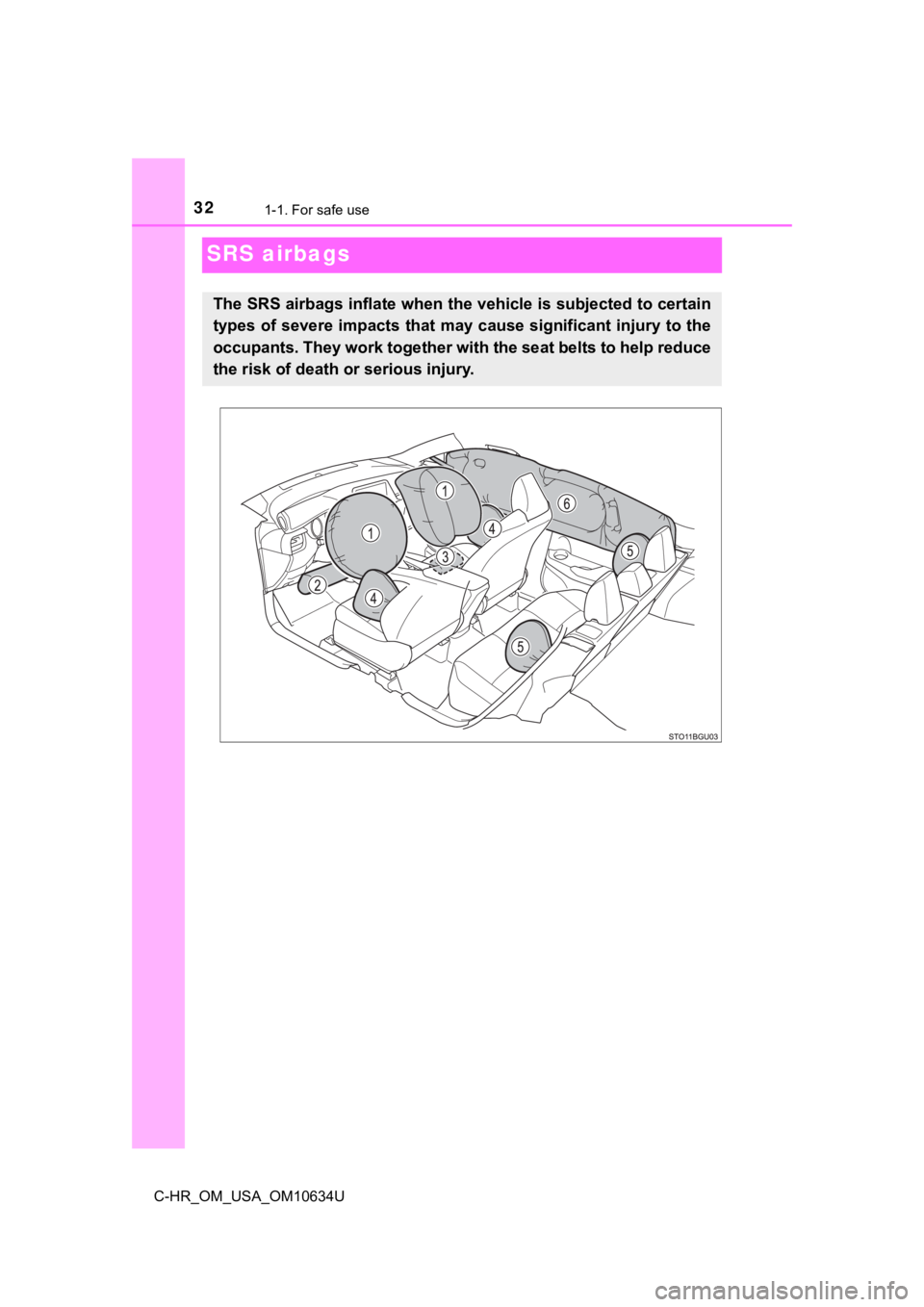
321-1. For safe use
C-HR_OM_USA_OM10634U
SRS airbags
The SRS airbags inflate when the vehicle is subjected to certain
types of severe impacts that may cause significant injury to th e
occupants. They work together wit h the seat belts to help reduce
the risk of death or serious injury.
Page 33 of 536

331-1. For safe use
1
For safety and security
C-HR_OM_USA_OM10634U
◆SRS front airbags
SRS driver airbag/front passenger airbag
Can help protect the head and chest of the driver and front passen-
ger from impact with interior components
SRS driver’s knee airbag
Can help provide driver protection
SRS front passenger’s seat cushion airbag
Can help restrain the front passenger
◆SRS side and curta in shield airbags
SRS front side airbags
Can help protect the torso o f the front seat occupants
SRS rear side airbags
Can help protect the torso of occ upants in the rear outer seats
SRS curtain sh ield airbags
● Can help protect primarily the head of occupants in the outer
seats
● Can help prevent the occupants fro m being thrown from the vehi-
cle in the event of vehicle rollover
Page 34 of 536

341-1. For safe use
C-HR_OM_USA_OM10634U
SRS airbag system components
Front impact sensors
Front passenger airbag
“AIR BAG ON” and “AIR BAG
OFF” indicator lights
Side impact sensors (front)
Side impact sensors (front
doors)
Seat belt pretensioners and
force limiters (front)
Side airbags (front)
Side airbags (rear)
Curtain shield airbags
Side impact sensors (rear)Driver’s seat p
osition sensor
Driver airbag
Driver’s knee airbag
SRS warning light
Airbag sensor assembly
Seat belt pretensioners and
force limiters (rear)
Seat cushion airbag
Front passenger’s seat belt
buckle switch
Driver’s seat belt buckle
switch
Front passenger occupant
classification system (ECU
and sensors)
Page 35 of 536

351-1. For safe use
1
For safety and security
C-HR_OM_USA_OM10634U
Your vehicle is equipped with ADVANCED AIRBAGS designed based
on the US motor vehicle safety standards (FMVSS208). The airbag
sensor assembly (ECU) controls airbag deployment based on infor-
mation obtained from the sensors etc. shown in the system compo -
nents diagram above. This informat ion includes crash severity and
occupant information. As the airbags deploy, a chemical reactio n in
the inflators quickly fills the airbags with nontoxic gas to he lp restrain
the motion of t he occupants.
WARNING
■SRS airbag precautions
Observe the following precautions regarding the SRS airbags.
Failure to do so may cause death or serious injury.
● The driver and all passengers in the vehicle must wear their se at belts
properly.
The SRS airbags are supplemental devices to be used with the se at belts.
● The SRS driver airbag deploys with considerable force, and can cause
death or serious injury especially if the driver is very close to the airbag.
The National Highway Traffic Safety Administration (NHTSA) advi ses:
Since the risk zone for the driver’s airbag is the first 2 - 3 in. (50 - 75 mm)
of inflation, placing yourself 10 in. (250 mm) from your driver airbag pro-
vides you with a clear margin of safety. This distance is measured from
the center of the steering wheel to your breastbone. If you sit less than
10 in. (250 mm) away now, you can change your driving position i n sev-
eral ways:
• Move your seat to the rear as far as you can while still reach ing the ped-
als comfortably.
• Slightly recline the back of the seat.
Although vehicle designs vary, many drivers can achieve the 10 in.
(250 mm) distance, even with the driver seat all the way forward , simply
by reclining the back of the seat somewhat. If reclining the ba ck of your
seat makes it hard to see the road, raise yourself by using a f irm, non-
slippery cushion, or raise the seat if your vehicle has that feature.
• If your steering wheel is adjustable, tilt it downward. This points the air-
bag toward your chest instead of your head and neck.
The seat should be adjusted as recommended by NHTSA above, whil e
still maintaining control of the foot pedals, steering wheel, and your view
of the instrument panel controls.
Page 36 of 536
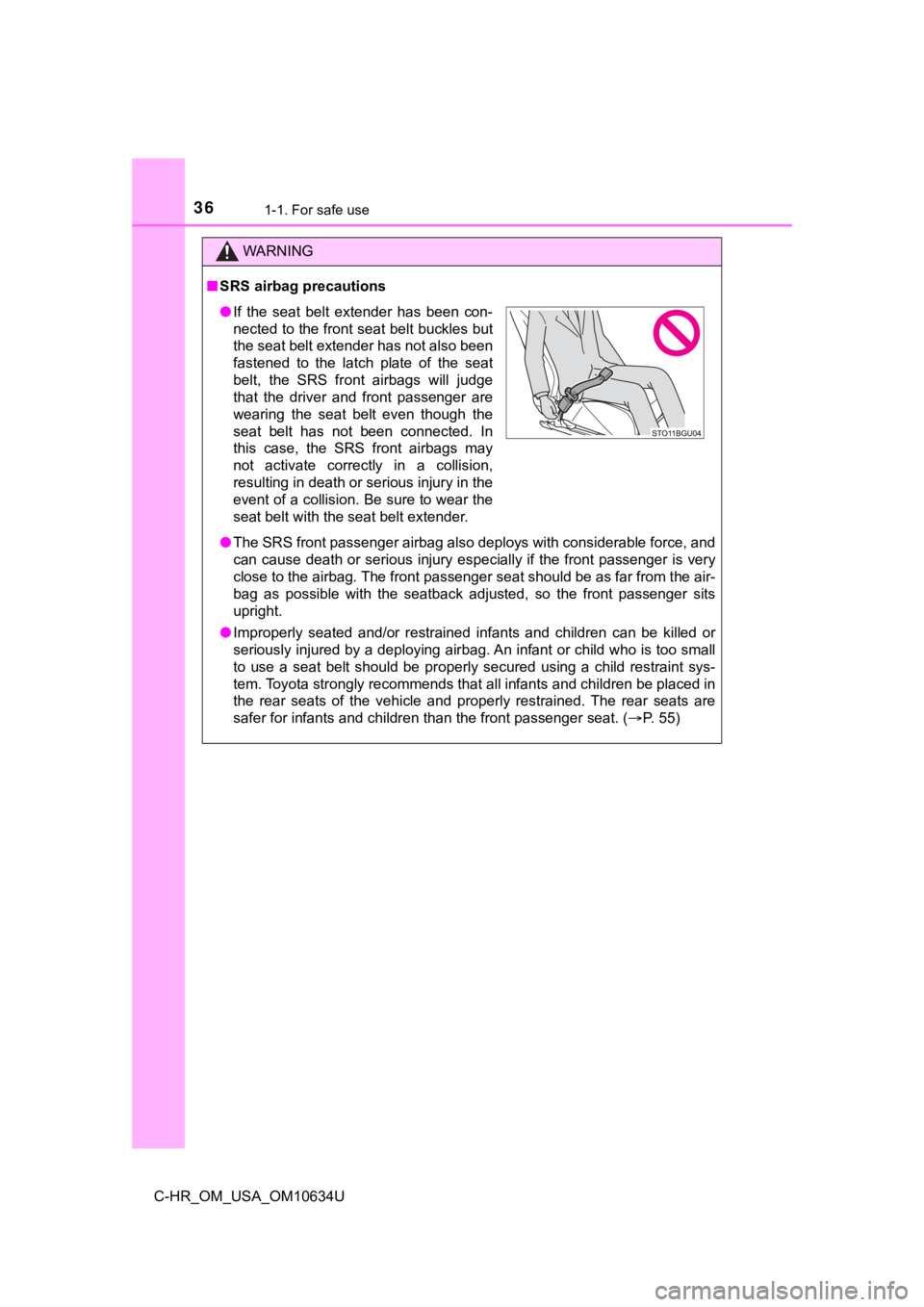
361-1. For safe use
C-HR_OM_USA_OM10634U
WARNING
■SRS airbag precautions
● The SRS front passenger airbag also deploys with considerable f orce, and
can cause death or serious injury especially if the front passe nger is very
close to the airbag. The front passenger seat should be as far from the air-
bag as possible with the seatback adjusted, so the front passenger sits
upright.
● Improperly seated and/or restrained infants and children can be killed or
seriously injured by a deploying airbag. An infant or child who is too small
to use a seat belt should be properly secured using a child restraint sys-
tem. Toyota strongly recommends that all infants and children b e placed in
the rear seats of the vehicle and properly restrained. The rear seats are
safer for infants and children than the front passenger seat. ( P. 55)
●If the seat belt extender has been con-
nected to the front seat belt buckles but
the seat belt extender has not also been
fastened to the latch plate of the seat
belt, the SRS front airbags will judge
that the driver and front passenger are
wearing the seat belt even though the
seat belt has not been connected. In
this case, the SRS front airbags may
not activate correctly in a collision,
resulting in death or serious injury in the
event of a collision. Be sure to wear the
seat belt with the seat belt extender.
Page 37 of 536
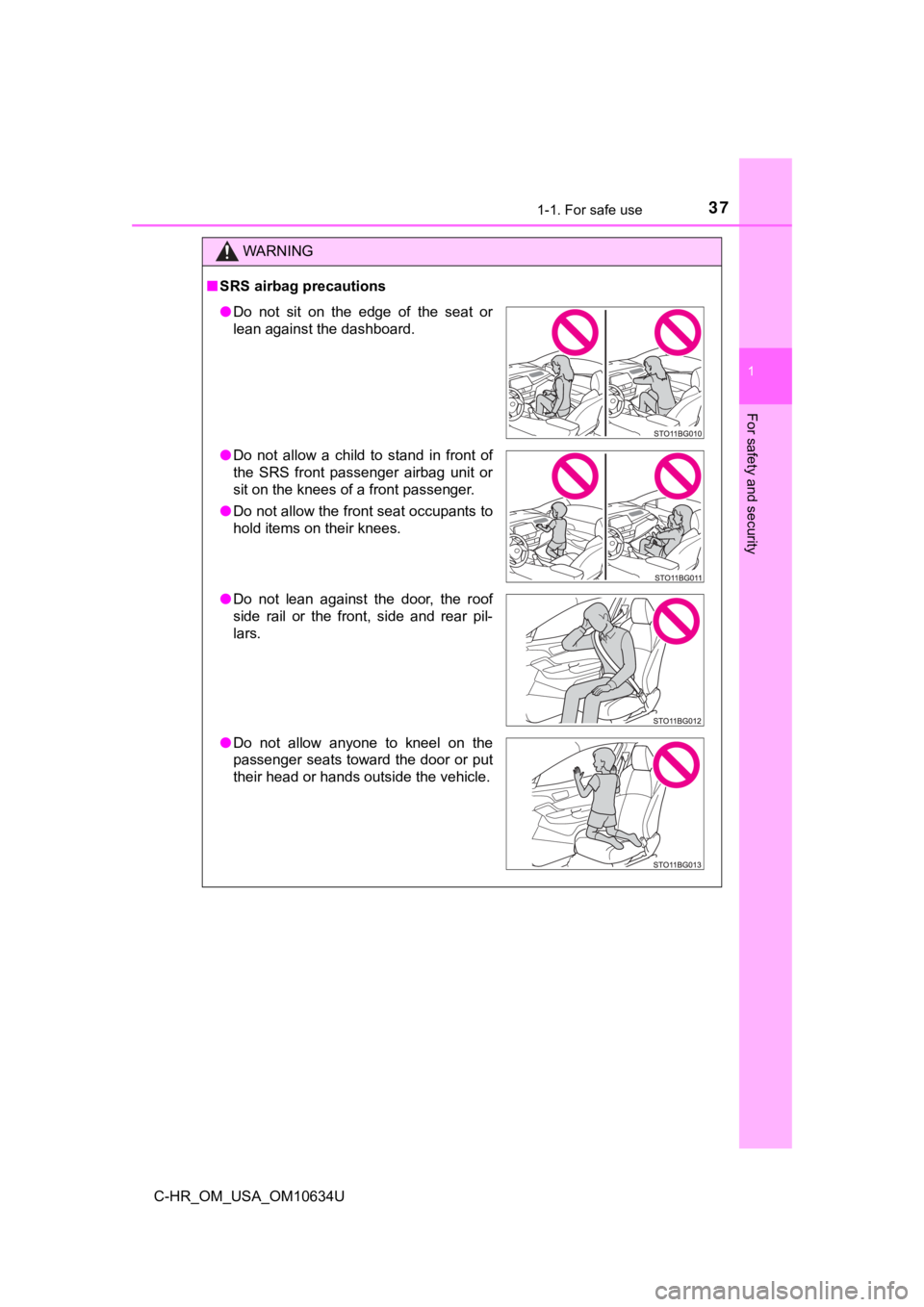
371-1. For safe use
1
For safety and security
C-HR_OM_USA_OM10634U
WARNING
■SRS airbag precautions
● Do not sit on the edge of the seat or
lean against the dashboard.
● Do not allow a child to stand in front of
the SRS front passenger airbag unit or
sit on the knees of a front passenger.
● Do not allow the front seat occupants to
hold items on their knees.
● Do not lean against the door, the roof
side rail or the front, side and rear pil-
lars.
● Do not allow anyone to kneel on the
passenger seats toward the door or put
their head or hands outside the vehicle.
Page 38 of 536
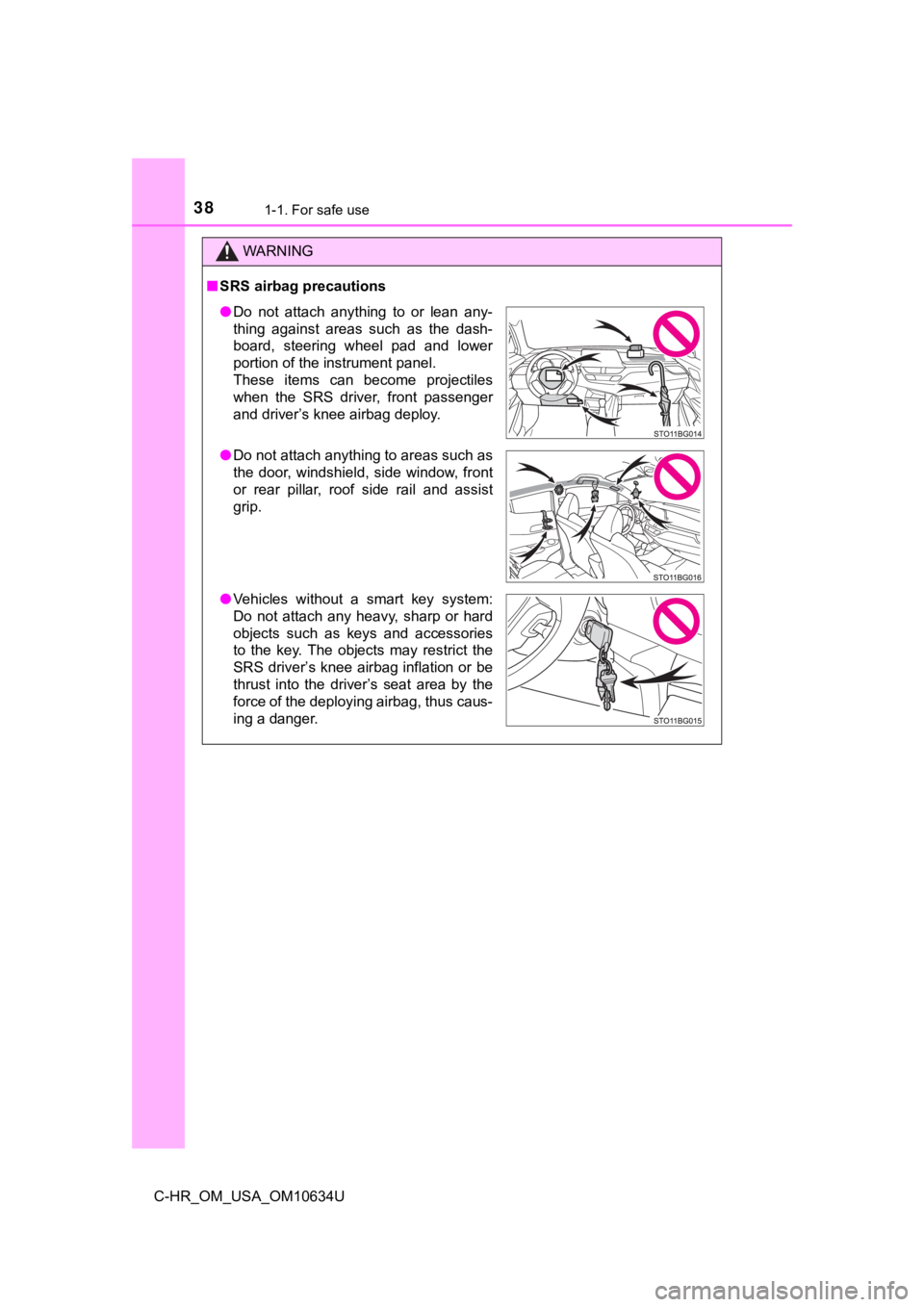
381-1. For safe use
C-HR_OM_USA_OM10634U
WARNING
■SRS airbag precautions
● Do not attach anything to or lean any-
thing against areas such as the dash-
board, steering wheel pad and lower
portion of the instrument panel.
These items can become projectiles
when the SRS driver, front passenger
and driver’s knee airbag deploy.
● Do not attach anything to areas such as
the door, windshield, side window, front
or rear pillar, roof side rail and assist
grip.
● Vehicles without a smart key system:
Do not attach any heavy, sharp or hard
objects such as keys and accessories
to the key. The objects may restrict the
SRS driver’s knee airbag inflation or be
thrust into the driver’s seat area by the
force of the deploying airbag, thus caus-
ing a danger.
Page 39 of 536

391-1. For safe use
1
For safety and security
C-HR_OM_USA_OM10634U
WARNING
■SRS airbag precautions
● If a vinyl cover is put on the area where the SRS driver’s knee airbag will
deploy, be sure to remove it.
● Do not use seat accessories which cover the parts where the SRS side
airbags and SRS seat cushion airbag inflate as they may interfe re with
inflation of the SRS airbags. Such accessories may prevent the side air-
bags and seat cushion airbag from activating correctly, disable the system
or cause the side airbags and seat cushion airbag to inflate accidentally,
resulting in death or serious injury.
● Do not strike or apply significant levels of force to the area of the SRS air-
bag components or the front doors.
Doing so can cause the SRS airbags to malfunction.
● Do not touch any of the component parts immediately after the S RS air-
bags have deployed (inflated) as they may be hot.
● If breathing becomes difficult after the SRS airbags have deplo yed, open a
door or window to allow fresh air in, or leave the vehicle if i t is safe to do
so. Wash off any residue as soon as possible to prevent skin ir ritation.
● If the areas where the SRS airbags are stored, such as the steering wheel
pad and front and rear pillars garnishes, are damaged or cracke d, have
them replaced by your Toyota dealer.
● Do not place anything, such as a cushion, on the front passenger’s seat.
Doing so will disperse the passenger’s weight, which prevents t he sensor
from detecting the passenger’s weight properly. As a result, th e SRS front
airbags for the front passenger may not deploy in the event of a collision.
Page 40 of 536

401-1. For safe use
C-HR_OM_USA_OM10634U
WARNING
■Modification and disposal of SRS airbag system components
Do not dispose of your vehicle or perform any of the following modifications
without consulting your Toyota dealer. The SRS airbags may malfunction or
deploy (inflate) accidentally, causing death or serious injury.
● Installation, removal, disassembly and repair of the SRS airbag s
● Repairs, modifications, removal or replacement of the steering wheel,
instrument panel, dashboard, seats or seat upholstery, front, s ide and rear
pillars or roof side rails or front door panels, trims and spea kers
● Modifications to the front door panel (such as making a hole in it)
● Repairs or modifications of the front fender, front bumper, or side of the
occupant compartment
● Installation of a grille guard (bull bars, kangaroo bar, etc.), snow plows,
winches or roof luggage carrier
● Modifications to the vehicle’s suspension system
● Installation of electronic devices such as mobile two-way radio s and CD
players
● Modifications to your vehicle for a person with a physical disa bility